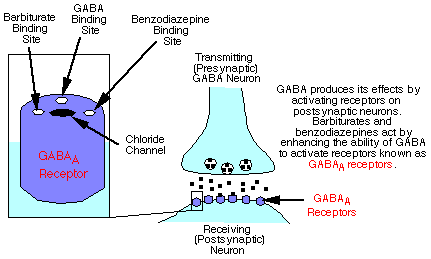Sedative-Hypnotics
History of Sedative-hypnotics
In 1903, barbital, a derivative of barbituric acid, was
introduced. Its sleep-inducing and anxiolytic effects made it very popular in
clinical medicine. It soon became popular as a treatment for anxiety and as the
first "sleeping pill". In 1912, phenobarbital was introduced. Phenobarbital, in
addition to sedative-hypnotic properties, has anticonvulsant properties and has
become one of the most important pharmacological treatments for epilepsy. The
success of barbital and phenobarbital spawned the synthesis of over 2,500
barbiturates. Of these many barbiturate analogues, only about 20 are still on
the market. The effects of these various barbiturates are generally similar,
differing primarily in potency and duration of action.
The partial separation of sedative-hypnotic-anesthetic from
anticonvulsant properties, found in phenobarbital, led researchers to search for
agents with more selective effects on the functions of the CNS. In the late
1930's, relatively nonsedative anticonvulsants were developed (e.g., phenytoin
and trimethadione). In 1957 the first benzodiazepine, chlordiazepoxide (Librium)
was synthesized. Benzodiazepines have demonstrated the ability to relieve
symptoms of anxiety with relatively little interference with cognitive function
or wakefulness. Benzodiazepines and barbiturates share very similar properties
but the benzodiazepines have demonstrated to have a much safer pharmacological
profile. Benzodiazepines have therefore replaced barbiturates for most uses,
particularly for treatment of anxiety and sleep disturbances.
Behavioral Effects in Humans
Sedative-hypnotic drugs depress behavior, moderate
excitement, and induce calmness. These drugs depress the central nervous system,
however, they usually produce therapeutic benefits at far lower doses than those
causing substantial generalized depression of behavior.
Barbiturates have a wider and more powerful effect on the
central nervous system than the other sedatives. The barbiturates can produce
varying degrees of depression of the CNS, ranging from mild sedation to general
anesthesia. In low doses barbiturates have a calming effect, and some of the
barbiturates (e.g., phenobarbital) have demonstrated selective anticonvulsant
properties. In moderate doses they produce a drunken euphoric state, similar to
alcohol. Sedation and sleep result from increased doses, and even higher doses
produce surgical anesthesia. Because of their ability to produce sedation and
decrease sleep latency, barbiturates were popular in the treatment of insomnia
prior to the advent of benzodiazepines. However, because of the high incidence
of tolerance and physical dependence following chronic use and the relatively
high danger of overdose, these drugs are rarely used today for the treatment of
anxiety or sleep disturbances.
Benzodiazepines share the sedative-hypnotic properties, but
produce fewer side effects than barbiturates. Like barbiturates, benzodiazepines
have also been reported to produce anticonvulsant effects. In addition, these
drugs are used clinically as muscle relaxants, antiepilieptic agents, and to
produce sedation before operative procedures. The antianxiety effects of
benzodiazepines are more selective than those of other sedative-hypnotics --
they relieve anxiety at lower doses and thus produce minimal sedation and motor
impairment. The benzodiazepines are currently the most important class of drugs
for treatment of anxiety and sleep disorders.
Mechanism of Action
Barbiturates and benzodiazepines act similarly to produce
depression of central nervous system function and behavior. Both classes of
drugs enhance the ability of the inhibitory neurotransmitter, gamma aminobutyric
acid (GABA), to activate a
type of receptors known as GABA-A receptors. These drugs increase the
effectiveness of GABA by altering the receptor so that GABA can bind more
easily, an effect known as allosteric regulation. Activation of the GABA-A
receptor opens an ion channel, allowing negatively charged chloride ions to
enter the cell, producing an inhibition of neuronal activity.

In addition to barbiturates and benzodiazepines,
ethanol appears to produce
depression of central nervous system function, in part by enhancing the ability
of GABA to bind to the GABA-A receptor. This may explain why these three classes
of drugs potentiate each others' effects and why tolerance to one results in
cross-tolerance to another.
Anxiolytic and
Sedative-hypnotics |
Generic Name |
Trade Name |
| Benzodiazepines |
Alprazolam |
Xanax |
| |
Chlordiazepoxide |
Librium |
| Clonazepam |
Klonopin |
| Clorazepate |
Tranxene |
| Diazepam |
Valium |
| Estazolam |
ProSom |
| Flurazepam |
Dalmane |
| Lorazepam |
Ativan |
| Midazolam |
Versed |
| Oxazepam |
Serax |
| Quazepam |
Doral |
| Temazepam |
Restoril |
| Triazolam |
Halcion |
| Halazepam |
Paxipam |
| Prazepam |
Centrax |
Non-Benzodiazepine anxiolytics
and hypnotics
|
Buspirone |
BuSpar |
| Chloral hydrate |
Noctec |
| Zolpidem tartrate |
Ambien |
Thought Questions and Quick Quiz
Thought Questions
- Drugs, such as benzodiazepines and alcohol, that are generally
depressant on behavior often produce excitatory effects, particularly at low
doses. How would you explain these apparently paradoxical effects?
- Barbiturates and benzodiazepines are effective for a variety of clinical
problems, ranging from anxiety and sleep disturbances to seizures. Given
their pharmacological effects, why do you suppose this is the case?
|

